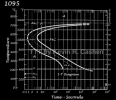Ok, here is the science (temps are in approximate ranges, not to the degree):
When the blade is 1400°F/760°C or higher, the structure is austenite.
When quenched fast enough the temperature drops below the pearlite nose at 1000°F/540°C
This keeps the structure as austenite.
If the quench is too slow for the steel type, the blade will become permanently soft pearlite. It will need to be re-hardened and a faster quenchant used. High carbon simple steels like the 10XX steels have a very shallow pearlite nose. The blade must drop from 1400°F/760°C to around 900°F/480°C in less than one second. High alloy and stainless steels have a much wider pearlite nose and may have many minutes before there is any risk of pearlite formation.
As it reaches 400°F/205°C the structure starts to convert to martensite. This is the Ms point (Martensitic start)
Depending on the steel type, the blade cools until all the austenite converts to martensite. This is the Mf point (Martensitic finish). This is around 150-200°F/65-90°C for carbon steels, and around -100°F./-75°C for high alloy and stainless steels. Now, while I said that "all the austenite converts", that isn't exactly true. In simple steels nearly all the austenite converts. In more complex and higher alloy steels, some austenite remains even at the Mf. This is called Retained Austenite. The first and second temper deal with that.
Between the pearlite nose and the Ms point the blade is easily bendable and soft austenite (technically it is super-cooled austenite). You can bend it at will with gloved hands, a straightening board, or a wooden mallet and a flat board (don't use metal tools as they may suck away heat too fast and cause uneven temperature drops).
As the blade crosses the Ms, the soft austenite starts to change into hard martensite. For the next100°F/40°C of cooling it is still pliable enough to straighten., but as it starts to stiffen you must IMMEDIATELY stop any straightening attempts.
At the Mf point the blade is brittle martensite. It will break if given any stress and can even break on its own if tempering is delayed.
The brittle Martensite need to be tempered to lose its brittle nature and become tougher. Starting around 400°F/205°C the blade becomes tougher but only a small amount softer. The standard tempering range is 400-450°F/205-235°C. At these temperatures the blade only loses a few Rockwell points below the as-quenched hardness ... but is much tougher.
The first temper takes care of the martensite hardness. During it, it also converts the retained austenite into new brittle martensite. This will be converted in the second temper.
So, in summation:
You can safely do simple straightening from just below the pearlite nose to just past the Martensitic Start point.
After the blade starts to stiffen, STOP all straightening until the end of the second temper.
Repeat - Do not do any further straightening until the end of the SECOND temper.
Once the second temper time is up, take the hot blade from the oven and clamp as needed to straighten. Place back in the oven for 15-30 minutes and remove. Dunk the whole blade and straightening jig in water to cool quickly. Check for straightness and re-clamp as needed if more is required. Place back in the oven for another 30 minutes and water quench again.
You can repeat this as many times as needed. After the blade is at room temperature, very minor straightening can be done with jigs and clamps, but any serious warp or bend needs to be done at 400°F/205°C

